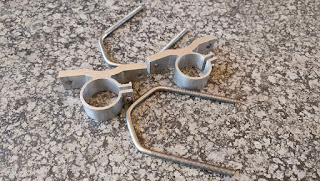Now what does the title of this topic relate to? A few weeks ago I noticed that one of my Diamond X50 UHF/VHF Antennas was completely "deaf". I could not receive the 145.750 Mhz Aasvoelkop Repeater which is situated just outside of Albertinia a distance of about 35 km from my QTH. In the past I could hear this repeater clearly with this specific X50 antenna, but with some rain on the signal. The other Diamond X50 is connected to the GRHub Network link radio and performs as it should. This antenna is 12 meters up in the air while the "deaf" antenna is two meters above my roof making the total height of this antenna above ground, 6 meters. The GRHub X50 was apart from the factory sealing also coated with Tectyl Glashelder Klar a transparent rust preventive clear spray. (Been successfully using this for years to seal and coat my antennas against natures elements) The "deaf" antenna was not and was installed with no protection at all. The day before I decided to take the "deaf" antenna down I did a quick test. You guessed correctly, no RX from the 145.750 Mhz repeater at all. A further puzzling factor was that the SWR reading was 1.2:1 but would drop to 1:1 . Power output was in spec with the radio's RF power output. Mind boggling? This antenna was now really "deaf" and needs to be looked at.
Once the antenna was on the ground I was quite surprised to see that natures elements at the sea was really minimal despite the fact that the antenna was up in the air for 2 years 3 months. Hereunder a few images of the antenna before refurbishing: (Click on images for larger view.)
I opened the antenna to see if the high voltage capacitor was not fried. The capacitor was fine and there were no dry joints. No corrosion or any signs of dampness/water penetration could be seen or found. The inside of the antenna was in great shape. What I did find was the the Allen Key Grub Screw was loose and did not make contact with the antenna connector. I fitted all the insides and tighten the grub screw firmly. I installed all the necessary parts and affix the antenna to my portable mast. Here under a few images of the antenna under testing: (Click on images for larger view.)
Testing with the above equipment is not ideal but that is all I have. The tests reveal that the antenna is now working as it should. I could trigger and receive the 145.750 Mhz repeater with the antenna just above the Parrot cages, which was far lower than before. The Diamond X50 Antenna was no longer "deaf".
The images underneath reflect the antenna after refurbishing: (Click on images for larger view.)
The Verdict:
I could not find anything wrong with the antenna nor the coaxial cable. The only issue that I found was that the Grub Screw that keeps the antenna connector affixed to the 3 x radial connector was loose and therefor their was no continuity between the radiating element and the "ground plane" connector of the antenna. Windy conditions would either result in a good or bad contact which might not have been the case when I used the deaf antenna. Whether the loose grub screw resulted in the deafness of the antenna is the only conclusion that I could come to. RF is a wonderful and mysterious element that could result in many good or bad issues.
A bit of sound advice that might be of assistance to other Diamond users:
- When you assemble the antenna ensure that all bolts, nuts and grub screws are tighten properly. Never assume like I did that the grub screw was tighten at the manufacturing plant.
- I would suggest you use additional sealant to protect the antenna from natures elements.
- Never use a sealant or grease that contain other metal elements like copper slip crease etc. Metal elements like copper, aluminum, stainless steal inter act with each other and hasten metal erosion and fatigue.
- Use a bit of marine grease on all bolts and nuts that screws into parts. Not on outer parts as the Tectyl will not adhere to the items. This will prevent nuts and bolts getting stuck due to corrosion.
- I suggest that you service (refurbish) this and other antennas at least once every two years
- Seal the PL259 that screws into the antenna with self amalgamating tape.
- Ensure that you have the correct type of Diamond Antenna for the area you live in. If you live in the "Cape of Storms" area I would not recommend large "oversized" antennas as the wind will definitely rearrange the antenna for you, resulting in damage. loss etc.
Finally:
One is never to old to learn about antennas. Many of us can oversee a small aspect that will result in the antenna not working as it should. Be very precise and meticulous when mounting and installing antennas and you will have many years of pleasure from your antennas. Remember maintenance is very important. Nothing last and works forever but you will extend the life of an antenna by thoroughly maintaining it. Enjoy!!

































